
Shareholder Letter Q4 2023

2
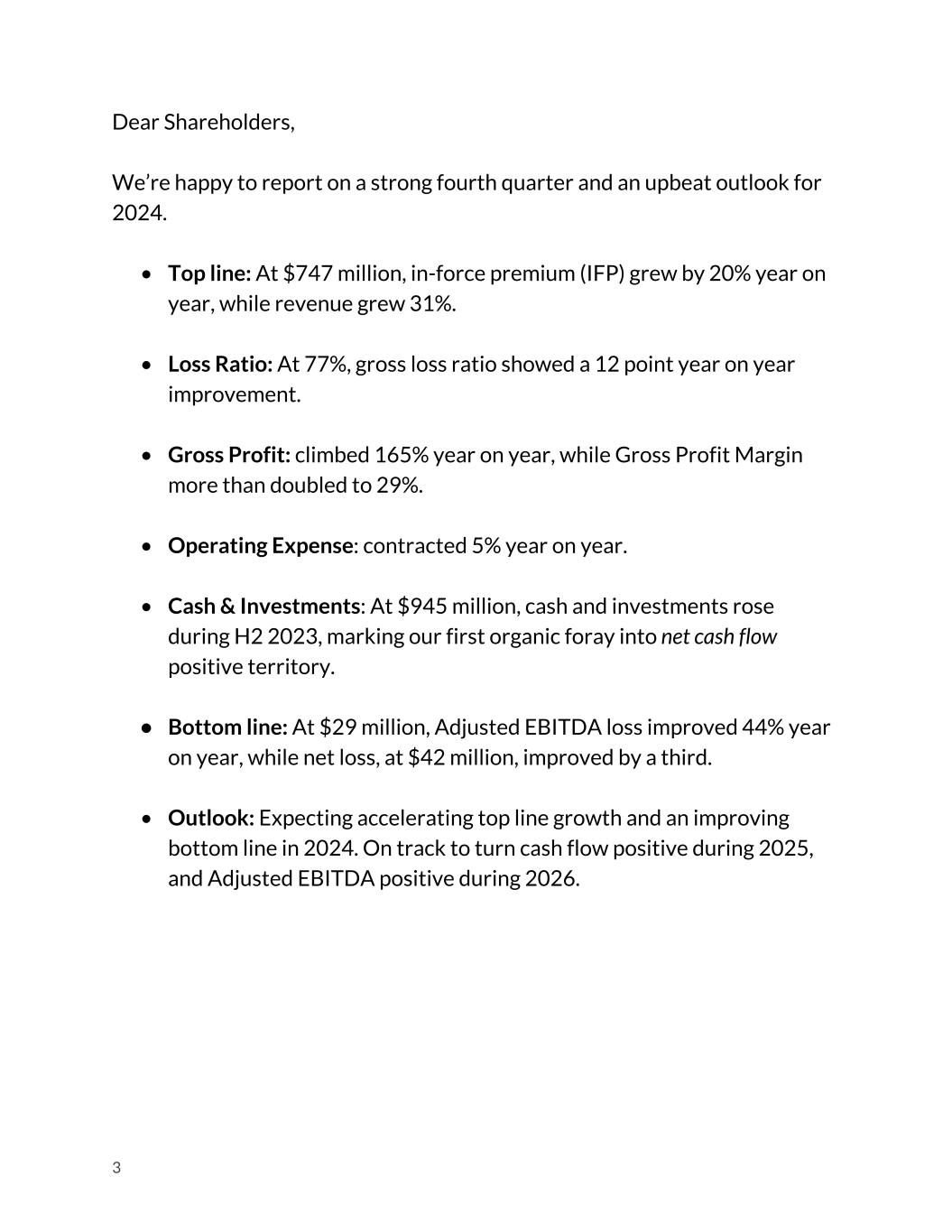
Dear Shareholders, We’re happy to report on a strong fourth quarter and an upbeat outlook for 2024. • Top line: At $747 million, in-force premium (IFP) grew by 20% year on year, while revenue grew 31%. • Loss Ratio: At 77%, gross loss ratio showed a 12 point year on year improvement. • Gross Profit: climbed 165% year on year, while Gross Profit Margin more than doubled to 29%. • Operating Expense: contracted 5% year on year. • Cash & Investments: At $945 million, cash and investments rose during H2 2023, marking our first organic foray into net cash flow positive territory. • Bottom line: At $29 million, Adjusted EBITDA loss improved 44% year on year, while net loss, at $42 million, improved by a third. • Outlook: Expecting accelerating top line growth and an improving bottom line in 2024. On track to turn cash flow positive during 2025, and Adjusted EBITDA positive during 2026. 3
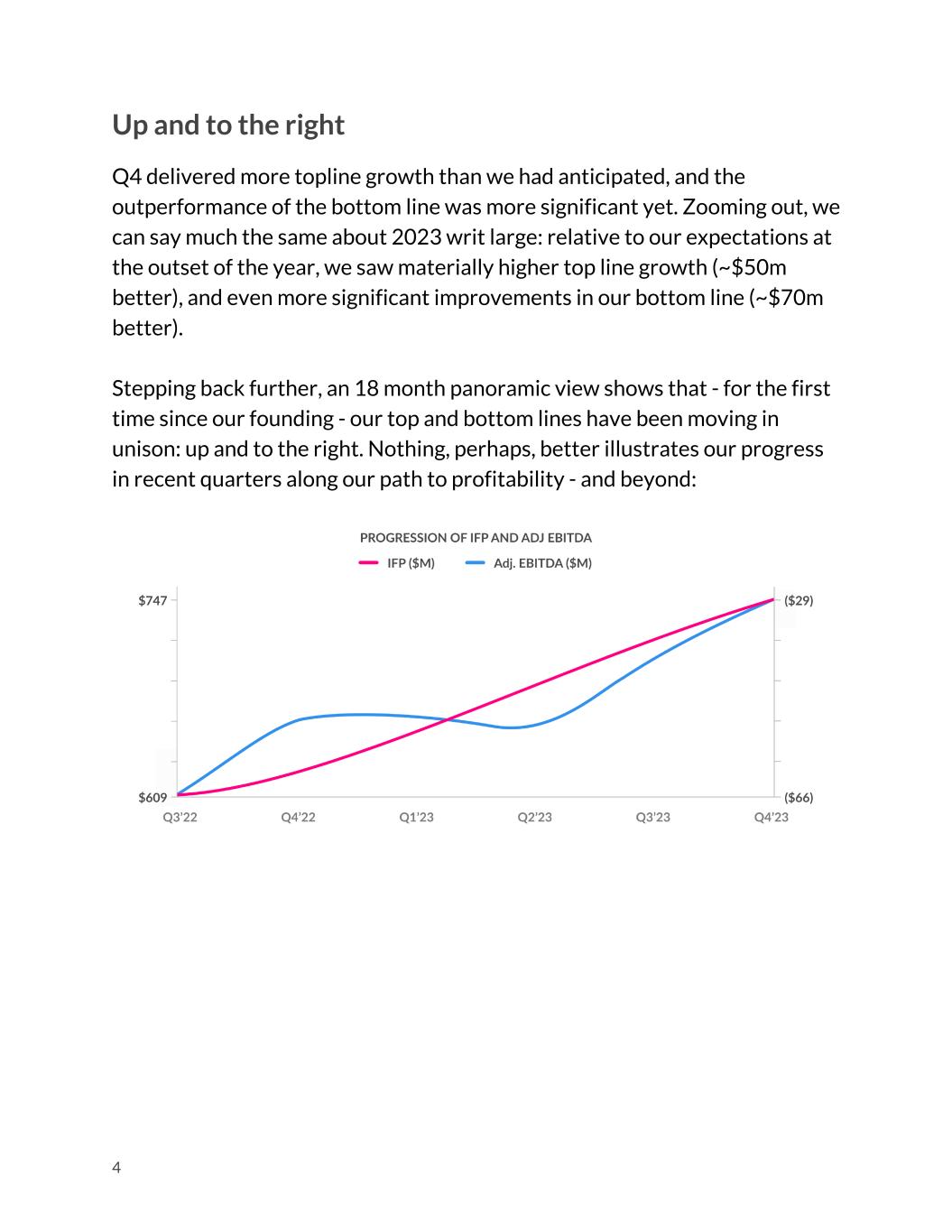
Up and to the right Q4 delivered more topline growth than we had anticipated, and the outperformance of the bottom line was more significant yet. Zooming out, we can say much the same about 2023 writ large: relative to our expectations at the outset of the year, we saw materially higher top line growth (~$50m better), and even more significant improvements in our bottom line (~$70m better). Stepping back further, an 18 month panoramic view shows that - for the first time since our founding - our top and bottom lines have been moving in unison: up and to the right. Nothing, perhaps, better illustrates our progress in recent quarters along our path to profitability - and beyond: 4

This growing profitability is also reflected in our Adjusted Gross Profit, which jumped nearly 170% over the same period: Looking forward, we expect to grow faster this year, and to see Adjusted EBITDA continue its upward progression. Importantly, though, we do not expect that progression to be entirely smooth. Beyond the surprises that are bound to blight our path, some reversals won’t be surprising at all. It is to these predictable regressions that we turn next. 5

Loss Ratio & Seasonality We delivered continued strong progress in our Q4 Gross Loss Ratio: a 12 point improvement year on year - 6 points sequentially - brought our loss ratio back into the 70s for the first time in over 2 years. While our target of <75% seems tantalizingly close, we want to caution that we expect continued bumpiness on our way, and that we may have not seen the last of the 80s quite yet. Despite the surprises that nature unleashes every now and then, loss ratios do have a forecastable rhythm to them. In large measure this traces back to the globe’s axial tilt and the familiar seasons it induces, though holiday and travel patterns also register on loss ratios in a broadly predictable way. 6

All of this is to provide some visibility into how our loss ratio is likely to evolve over the coming quarters. While we believe our loss ratio will continue to trend downwards (with occasional bona fide surprises), this positive momentum will face seasonal headwinds in Q1, and these typically strengthen in Q2. Depending on which of these countervailing forces prevails, we may see some deterioration in loss ratios quarter-over-quarter - though hopefully not year-over-year (YoY). For this reason, comparing the quarterly loss ratio with the same period from the previous year provides a more credible read on our progress than a quarter-over- quarter comparison. 7

Better yet, opening the aperture, from the 90-day lookback of the ‘quarterly loss ratio’, to take in the full trailing twelve months (TTM), further denoises results and boosts credibility. TTM loss ratio does a decent job of neutralizing not only predictable reversals, but the unpredictable ones too. Consider how in 2023 we had two ‘surprises’: Q2 suffered surprisingly high CAT losses, while Q4 CATs came in slightly lighter than forecasted. On an annual basis, however, 2023’s CAT load came in very much in line with our models. In isolation, then, the quarterly loss ratios of both Q2 and Q4 may have sent false signals (the first unduly negative, the second unduly positive), and looking at these quarterly results YoY would not have corrected for this: Q2 showed an 8 point deterioration YoY, while Q4 shows a 12 point improvement YoY - a dramatic turnaround in just two quarters. On the other hand, on a TTM basis, Q2 showed a 4 point deterioration YoY, and Q4 a 5 point improvement YoY. As the chart that follows suggests, our TTM loss ratio - and the steadier improvement it captures - is probably a more bankable testament to our actual performance throughout 2023. 8

In the insurance industry it is customary to share a trailing twelve months loss ratio just once a year, at the end of each year (AKA: Annual Loss Ratio) - and in 2023 ours was 85%, down from 90% in 2022. We believe this trailing 12 month view does add a more credible perspective on longer term trends. Going forward, we expect to share our TTM Loss Ratio (we’ll always share the quarterly too), in an effort to give you a less noisy view of our results, and a more comprehensive view of our progress. We hope the foregoing proves helpful when assessing our reported loss ratio progress. For the day-to-day management of Lemonade, however, we prefer leading indicators to the trailing kind. Which brings us to AI… 9

LTV 9 Our improving loss ratio, and our growing powers of prognostication, owe much to our suite of homegrown AIs, and specifically to one we refer to fondly as ‘LTV’. This composite AI harnesses some 50 machine learning models to predict, for each customer, their lifetime value, or LTV, in net present dollar terms. The models make an array of real time predictions, including the lifetime loss ratio of each customer, though their key output is a simple dollar figure, representing the net present value of any given customer. Many of our business processes rely on these few digits. For example, LTV dictates which products, which geographies and which advertising campaigns receive the incremental marketing dollar, a hugely influential decision with real impact on our loss ratio and profitability. Last month our 9th generation of LTV went live. Like the launch of a state-of- the-art telescope, each generation of LTV lets us see deeper and with greater fidelity than we previously could, revealing the component parts of risk- clumps that seemed monolithic under less powerful models. This process of de-averaging - breaking apart seemingly homogeneous groups to expose their constituent parts - is a strategic advantage our LTV AI affords us. The resultant individualization of risk is the key to positive risk selection, and the best defense against adverse selection. The more our models push the boundaries of individualization, the more we deepen this competitive advantage. Beyond its growing power to disaggregate, each generation of LTV also refines our ability to evaluate things in aggregate. One of the things LTV 9 has revealed so far is that, on average, our Renters business generates 12% higher LTVs than prior models predicted; that our Pet customers’ LTV is very robust and little changed from prior models; and that we may have been 10

overestimating the LTV of our Car and, to a greater extent, our Home customers. All these insights flow into our systems, and our targeting and spend allocation gets instantly more refined and rewarding. As a reminder, the AI making the LTV predictions uses the rates in effect at the moment the sale is made, and is blind to new rates that may be expected to kick in in the future, raising LTVs as customers renew. In this important sense, LTV is conservative by design. As our filings for Home and Car get approved and implemented, these will boost the LTV of customers buying (or renewing) these products, and the system will adjust in real time. Though in the case of Home, there’s more to the story… 11

Homeowners… still a way to go In the US, during the years 1980–2022, the insurance industry reported an average of 8 events each year where overall claims costs exceeded $1 billion (inflation-adjusted). In more recent years (2018–2022) that average more than doubled to 18 events, and in 2023 we saw 28 such events. Beyond that ominous incident count, what particularly stood out in 2023 was the unprecedented damage wrought by severe storms in the first half of the year: 1980-2023 ‘Severe-Storm’ Damage (CPI-Adjusted) Source: NOAA National Centers for Environmental Information (NCEI) U.S. Billion-Dollar Weather and Climate Disasters 12

These figures capture not only how the weather has been increasingly battering homeowners, but how inflation has been too. In recent years, the costs for home repairs have been consistently and significantly higher than the core CPI inflation rate: This double whammy - increasing CATs and rising costs of repair - has come as regulators are often understaffed (following COVID-19) and overwhelmed (as insurers inundate them with applications to raise rates), hampering insurers’ ability to adjust rates at a time that they needed adjusting the most. Triple whammy. 13

At Lemonade we have observed these trends for some time, and have been proactively rebalancing our portfolio to reduce our homeowners exposure in many areas. The chart below shows what percentage of newly written premiums came from homeowners policies in recent years: This notable drop is in line with our determination to grow only through profitable products in profitable areas - a policy reflected in both our slowing growth rates, and declining loss ratios, in 2023. Importantly, our rebalancing was far more targeted than the headline numbers convey, and the cutbacks were predominantly in areas where CATs are frequent and rate approvals are not. For example, in mid 2021 some 37% of all our newly written homeowners premiums were written in California, and that number has dropped steadily, flatlining at around one percent by the start of 2023: 14
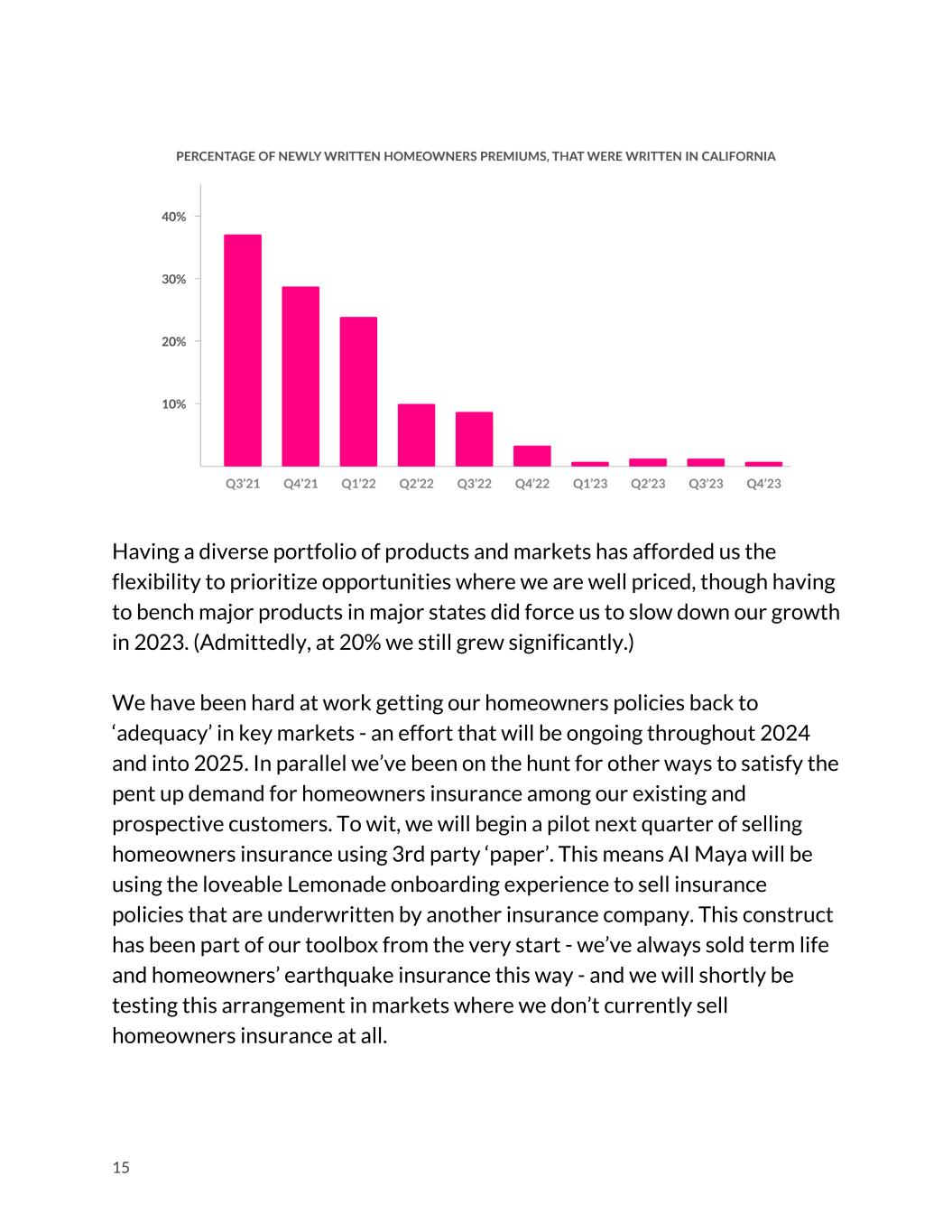
Having a diverse portfolio of products and markets has afforded us the flexibility to prioritize opportunities where we are well priced, though having to bench major products in major states did force us to slow down our growth in 2023. (Admittedly, at 20% we still grew significantly.) We have been hard at work getting our homeowners policies back to ‘adequacy’ in key markets - an effort that will be ongoing throughout 2024 and into 2025. In parallel we’ve been on the hunt for other ways to satisfy the pent up demand for homeowners insurance among our existing and prospective customers. To wit, we will begin a pilot next quarter of selling homeowners insurance using 3rd party ‘paper’. This means AI Maya will be using the loveable Lemonade onboarding experience to sell insurance policies that are underwritten by another insurance company. This construct has been part of our toolbox from the very start - we’ve always sold term life and homeowners’ earthquake insurance this way - and we will shortly be testing this arrangement in markets where we don’t currently sell homeowners insurance at all. 15

Cash & Investments Something noteworthy happened in H2 2023: our total cash levels rose. We ended Q2 with $942m in ‘cash and investments’, while we ended both Q3 and Q4 with $945m. This suggests we’ve been flirting with net cash flow positivity (i.e. a favorable change in cash and investments) for a couple of quarters now. This isn’t our new normal quite yet, though we’re not far off either. During 2024 we will likely burn, rather than generate cash, but far less than our projected Adjusted EBITDA losses would imply. This, too, is noteworthy, since Adjusted EBITDA has historically been a reasonable proxy for net cash flow. In H1 2023, for example, we reported a $104m Adjusted EBITDA loss, and our total cash and investments dipped by $98m. The two were never identical, but for years they moved in tandem. No longer. While in H2 2023 Adjusted EBITDA made significant strides along our path to profit, net cash flow raced ahead. We expect this ‘decoupling’ to be in evidence throughout 2024: relative to 2023, improvements in our Adjusted EBITDA will slow this year, while improvements in our cash burn will likely accelerate. The explanation for both is rooted in our plan to accelerate growth in 2024, while upscaling the Synthetic Agents from funding 50% of growth spending in H2 2023, to 80% in 2024. As we detail below, that increased growth spending will impact our sales and marketing expense line, but as we’ll be spending primarily the Synthetic Agents’ cash, it won’t make a sizable dent in our cash position. The upshot is that we expect net cash flow to turn consistently positive in H1 next year. Unlike net cash flow, cash flow from operations receives no help from Synthetic Agents, and will likely turn positive later in 2025. Adjusted EBITDA is expected to follow suit about one year after that. 16

Europe comes of age Our European business made solid strides in 2023, with increasingly healthy loss ratios and profitable unit economics, and the launch of the UK market - which quickly became our largest customer base in Europe. Our European business is still dwarfed by our US book, but it is faster growing (~100% IFP growth in 2023) and has much to commend it. Of particular note is the favorable regulatory environment: we have freedom to adjust prices dynamically and without pre-approvals. Likewise, the EU and UK are far less CAT-exposed than is the US. Indeed, in Q4, about 30% of our net-new customers came from our European business - as compared to a mere 3%, 18 months ago. The US still adds far more new customers absolutely, but given its size it also has far higher absolute numbers of churn. As a result, net-new customer additions in Europe are closing in on those in the US. Our European business is headquartered in Amsterdam, and this is an opportune time to commend our EU team for the outstanding work they 17
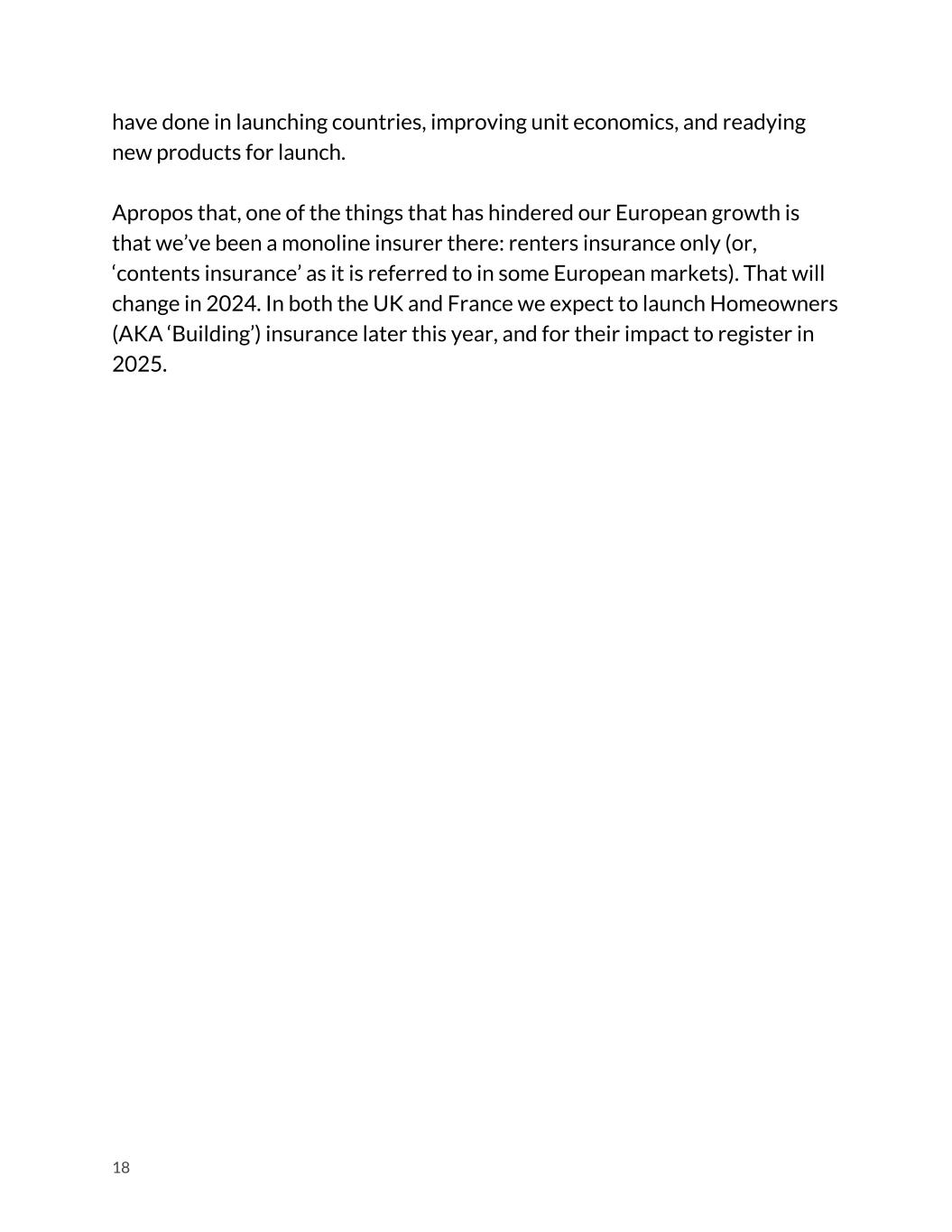
have done in launching countries, improving unit economics, and readying new products for launch. Apropos that, one of the things that has hindered our European growth is that we’ve been a monoline insurer there: renters insurance only (or, ‘contents insurance’ as it is referred to in some European markets). That will change in 2024. In both the UK and France we expect to launch Homeowners (AKA ‘Building’) insurance later this year, and for their impact to register in 2025. 18
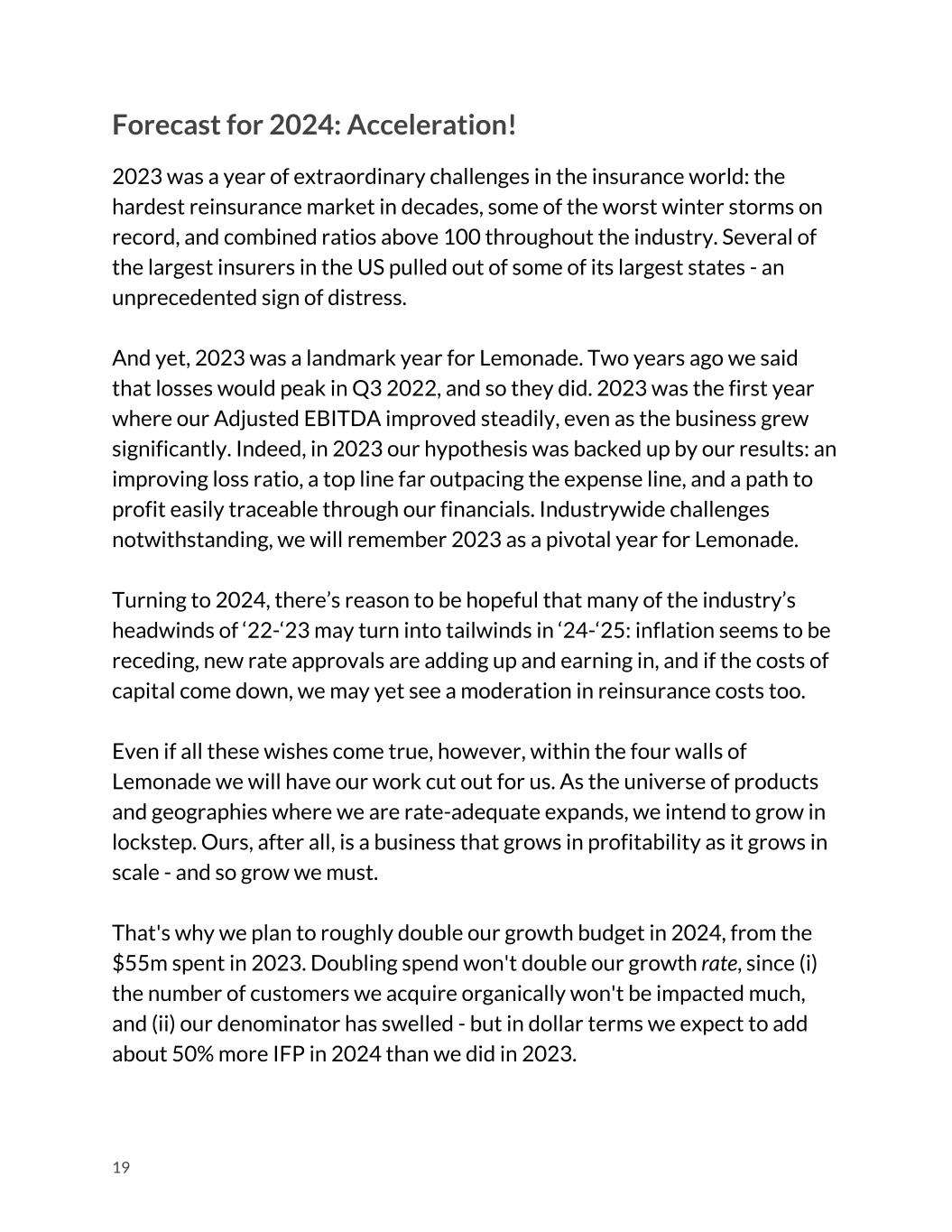
Forecast for 2024: Acceleration! 2023 was a year of extraordinary challenges in the insurance world: the hardest reinsurance market in decades, some of the worst winter storms on record, and combined ratios above 100 throughout the industry. Several of the largest insurers in the US pulled out of some of its largest states - an unprecedented sign of distress. And yet, 2023 was a landmark year for Lemonade. Two years ago we said that losses would peak in Q3 2022, and so they did. 2023 was the first year where our Adjusted EBITDA improved steadily, even as the business grew significantly. Indeed, in 2023 our hypothesis was backed up by our results: an improving loss ratio, a top line far outpacing the expense line, and a path to profit easily traceable through our financials. Industrywide challenges notwithstanding, we will remember 2023 as a pivotal year for Lemonade. Turning to 2024, there’s reason to be hopeful that many of the industry’s headwinds of ‘22-‘23 may turn into tailwinds in ‘24-‘25: inflation seems to be receding, new rate approvals are adding up and earning in, and if the costs of capital come down, we may yet see a moderation in reinsurance costs too. Even if all these wishes come true, however, within the four walls of Lemonade we will have our work cut out for us. As the universe of products and geographies where we are rate-adequate expands, we intend to grow in lockstep. Ours, after all, is a business that grows in profitability as it grows in scale - and so grow we must. That's why we plan to roughly double our growth budget in 2024, from the $55m spent in 2023. Doubling spend won't double our growth rate, since (i) the number of customers we acquire organically won't be impacted much, and (ii) our denominator has swelled - but in dollar terms we expect to add about 50% more IFP in 2024 than we did in 2023. 19

The upshot is that we are on a trajectory of steadily gaining velocity, as we smoothly accelerate our growth rate back to our target baseline of 25% CAGR, and beyond. The associated spend, and the resultant growth, should boost our bottom line a couple of years hence, but it will weigh on our bottom line in the coming quarters. Threading that needle - doubling growth spend while shrinking Adjusted EBITDA losses - will be our central challenge in 2024. To be clear, as our guidance below shows, we believe we are up to this challenge: we expect our Adjusted EBITDA to improve in 2024, notwithstanding the immediate downforce created by accelerated growth. We expect to pull off this maneuver thanks to our systems continuing to drive down our loss ratio, while driving up our operational efficiencies. We anticipate that the contributions of these two forces will more than offset the additional ~$55m we plan to spend on growth in 2024. In closing, we’ll share that we're excited to step on the gas once more. Beyond being the smart thing for the business, it’s also a thrill for us as a 20

team. We were built for speed, and we can’t wait to shift gears and to feel the wind in our face once more. ---------------------------- Please note: on our investor relations website, we have published Supplementary Shareholder Information, a document that provides additional color on several important topics covered in this letter, including our Synthetic Agents program, trends on cash flow from operating activities, and our new reinsurance structure, which went into effect in July 2023. 21

Q4 2023 Results, KPIs and Non-GAAP Financial Measures In Force Premium IFP, defined as the aggregate annualized premium for customers as of the period end date, increased by 20% to $747 million as compared to the fourth quarter of 2022. Customers Customer count increased by 12% to 2,026,918 as compared to the fourth quarter of 2022. Premium per Customer Premium per customer, defined as in force premium divided by customers, was $369 at the end of the fourth quarter, up 7% from the fourth quarter of 2022. Annual Dollar Retention ADR, defined as the percentage of IFP retained over a twelve month period, inclusive of changes in policy value, changes in number of policies, changes in policy type, and churn, was 87% at the end of the fourth quarter, an increase of 1 percentage point from fourth quarter of 2022. Gross Earned Premium Fourth quarter gross earned premium of $181 million increased by $29.7 million or 20% as compared to the fourth quarter of 2022, primarily due to the increase of IFP earned during the quarter. 22

Revenue Fourth quarter revenue of $115.5 million increased by $27.1 million or 31% as compared to the fourth quarter of 2022, primarily due to the increase of gross earned premium during the quarter, coupled with greater investment income. Gross Profit Fourth quarter gross profit of $33.6 million increased by $20.9 million or 165% as compared to the fourth quarter of 2022, primarily due to higher earned premium and improved loss ratio in the fourth quarter this year. Adjusted Gross Profit Fourth quarter adjusted gross profit of $35.3 million increased by $17.4 million or 97% as compared to the fourth quarter of 2022, primarily due to higher earned premium and improved loss ratio in the fourth quarter. Adjusted gross profit is a non-GAAP metric. Reconciliations of GAAP to non- GAAP financial measures, as well as definitions for the non-GAAP financial measures included in this letter and the reasons for their use, are presented at the end of this letter. Operating Expense Total operating expense, excluding net loss and loss adjustment expense, of $90.1 million decreased by $4.9 million or 5% as compared to the fourth quarter of 2022. The decrease was primarily driven by lower employee related costs. Net Loss Net loss in the fourth quarter was $42.4 million, or $(0.61) per share, as compared to $63.7 million, or $(0.93) per share, in the fourth quarter of 2022, an improvement in net loss of 33% in just a year. 23

Adjusted EBITDA Adjusted EBITDA loss of $28.9 million decreased by $22.8 million as compared to an Adjusted EBITDA loss of $51.7 million in the fourth quarter of 2022, primarily due to higher revenue, improved loss ratio and lower operating expenses in the fourth quarter. Adjusted EBITDA is a non-GAAP metric. Reconciliations of GAAP to non- GAAP financial measures, as well as definitions for the non-GAAP financial measures included in this letter and the reasons for their use, are presented at the end of this letter. Cash & Investments The Company’s cash, cash equivalents, and investments totaled approximately $945 million at December 31, 2023, reflecting primarily the $119 million of net cash used in operations since December 31, 2022. As of December 31, 2023, approximately $182 million is carried by our insurance subsidiaries as statutory surplus for the benefit of their policyholders. 24
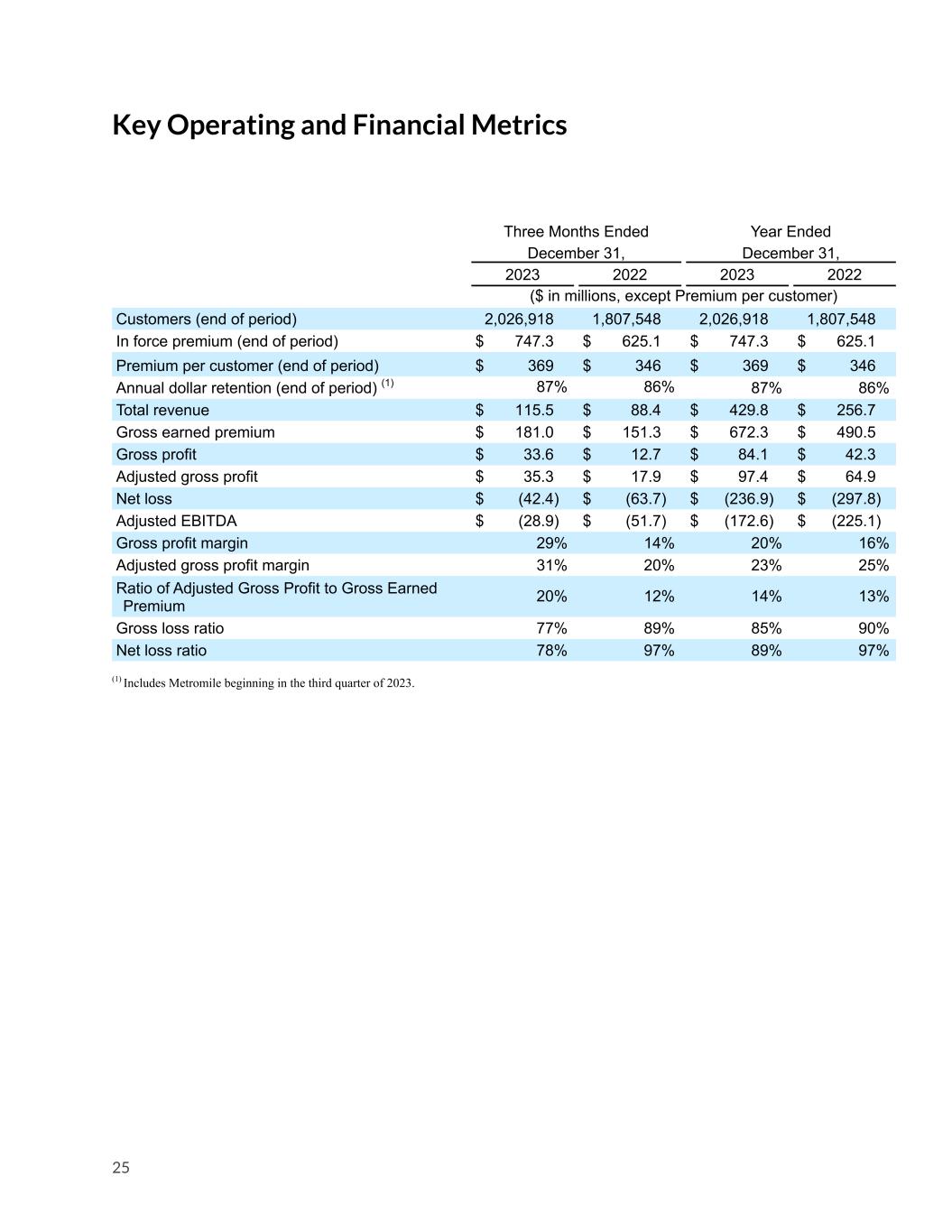
Key Operating and Financial Metrics Three Months Ended December 31, Year Ended December 31, 2023 2022 2023 2022 ($ in millions, except Premium per customer) Customers (end of period) 2,026,918 1,807,548 2,026,918 1,807,548 In force premium (end of period) $ 747.3 $ 625.1 $ 747.3 $ 625.1 Premium per customer (end of period) $ 369 $ 346 $ 369 $ 346 Annual dollar retention (end of period) (1) 87% 86% 87% 86% Total revenue $ 115.5 $ 88.4 $ 429.8 $ 256.7 Gross earned premium $ 181.0 $ 151.3 $ 672.3 $ 490.5 Gross profit $ 33.6 $ 12.7 $ 84.1 $ 42.3 Adjusted gross profit $ 35.3 $ 17.9 $ 97.4 $ 64.9 Net loss $ (42.4) $ (63.7) $ (236.9) $ (297.8) Adjusted EBITDA $ (28.9) $ (51.7) $ (172.6) $ (225.1) Gross profit margin 29% 14% 20% 16% Adjusted gross profit margin 31% 20% 23% 25% Ratio of Adjusted Gross Profit to Gross Earned Premium 20% 12% 14% 13% Gross loss ratio 77% 89% 85% 90% Net loss ratio 78% 97% 89% 97% (1) Includes Metromile beginning in the third quarter of 2023. 25

Guidance First Quarter 2024 We expect: • In force premium at March 31, 2024 of $789 - $791 million (~21% growth YoY) • Gross earned premium of $183 - $185 million (~20% growth YoY) • Revenue of $111 - $113 million (~19% growth YoY) • Adjusted EBITDA loss of ($43) - ($41) million (~19% improvement YoY) • Stock-based compensation expense of approximately $15 million • Capital expenditures of approximately $2 million • Weighted total common shares outstanding of approximately 70 million shares Full Year 2024 We expect: • In force premium at December 31, 2024 of $938 - $942 million (~26% growth YoY) • Gross earned premium of $815 - $820 million (~22% growth YoY) • Revenue of $505 - $510 million (~19% growth YoY) • Adjusted EBITDA loss of ($160) - ($155) million (~10% improvement YoY) • Stock-based compensation expense of approximately $60 million • Capital expenditures of approximately $10 million • Weighted total common shares outstanding of approximately 71 million shares 26
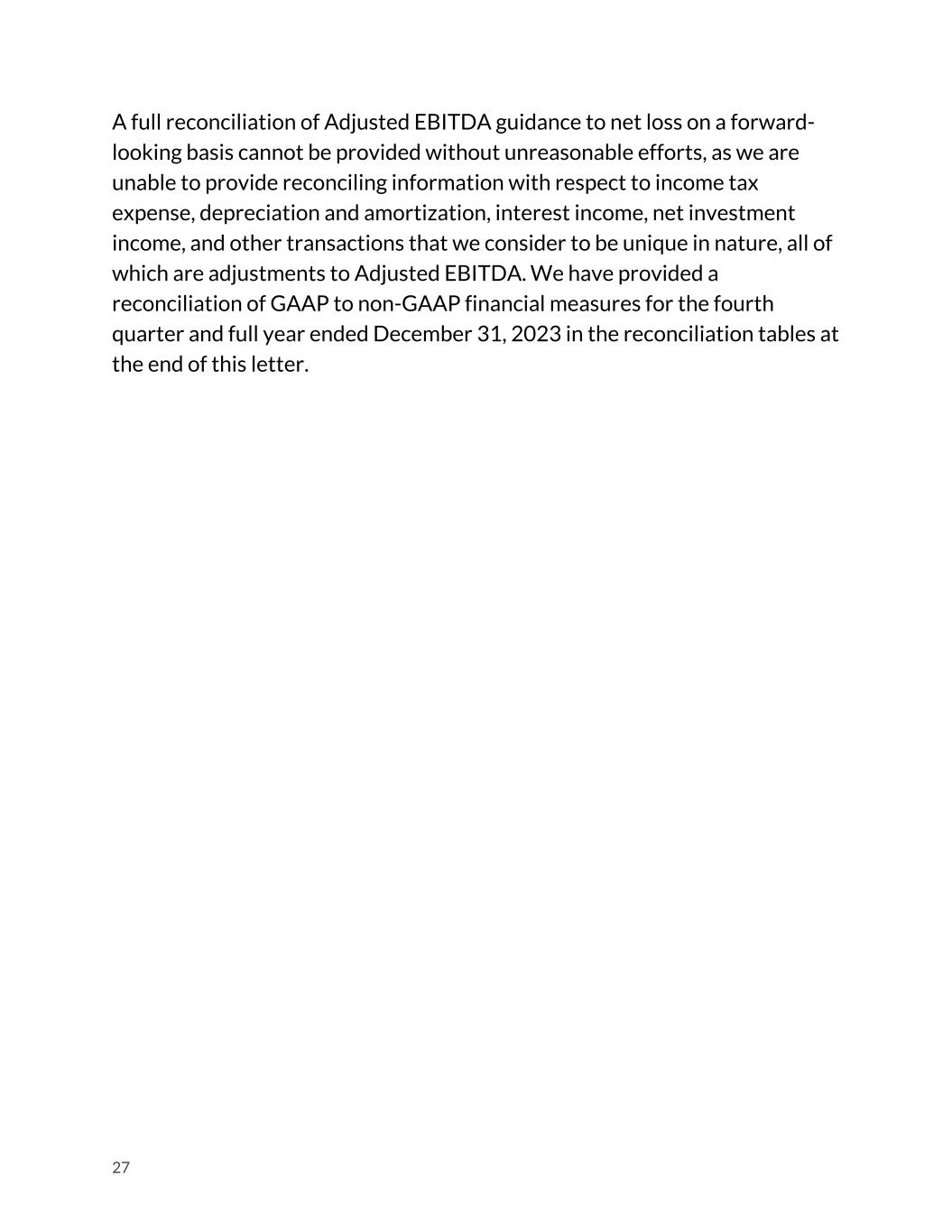
A full reconciliation of Adjusted EBITDA guidance to net loss on a forward- looking basis cannot be provided without unreasonable efforts, as we are unable to provide reconciling information with respect to income tax expense, depreciation and amortization, interest income, net investment income, and other transactions that we consider to be unique in nature, all of which are adjustments to Adjusted EBITDA. We have provided a reconciliation of GAAP to non-GAAP financial measures for the fourth quarter and full year ended December 31, 2023 in the reconciliation tables at the end of this letter. 27
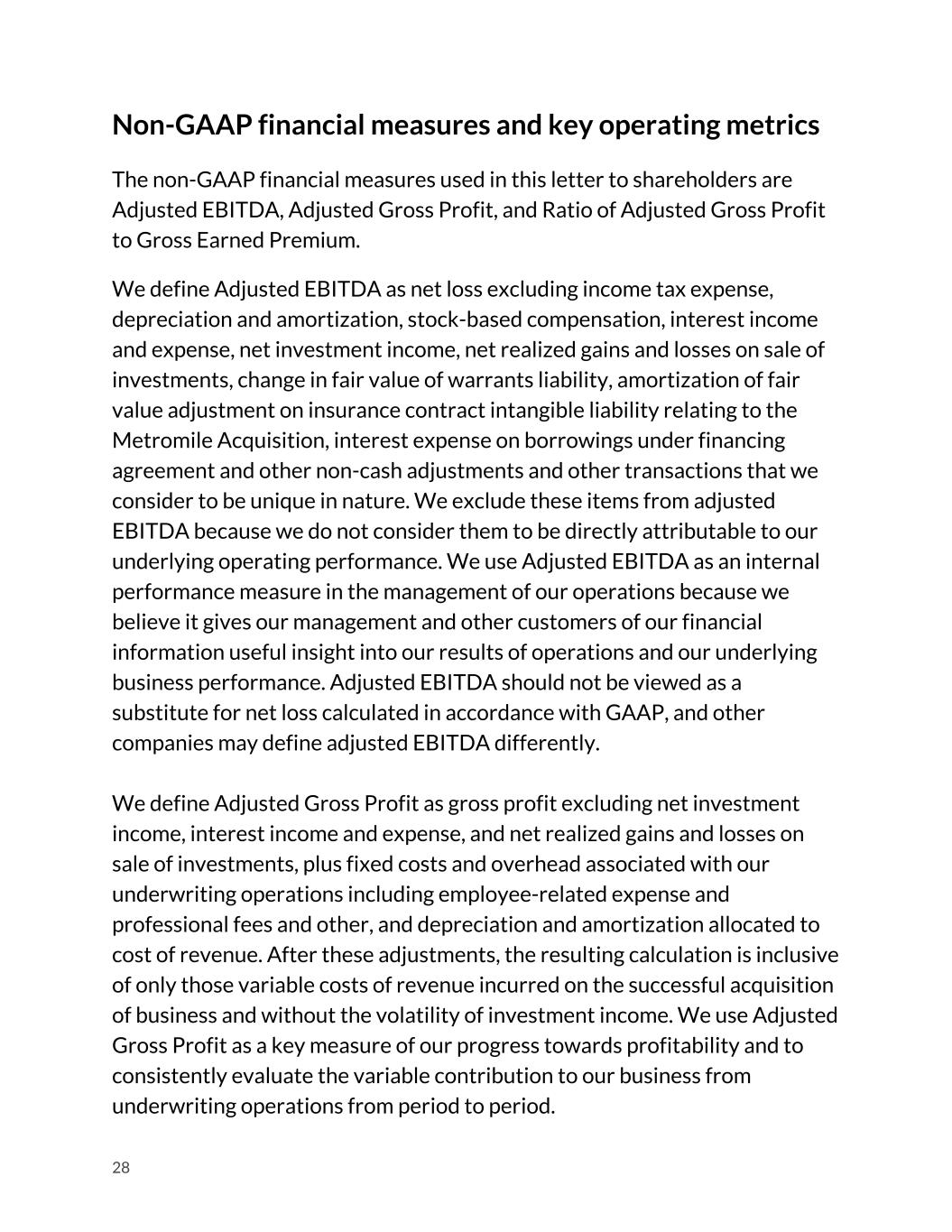
Non-GAAP financial measures and key operating metrics The non-GAAP financial measures used in this letter to shareholders are Adjusted EBITDA, Adjusted Gross Profit, and Ratio of Adjusted Gross Profit to Gross Earned Premium. We define Adjusted EBITDA as net loss excluding income tax expense, depreciation and amortization, stock-based compensation, interest income and expense, net investment income, net realized gains and losses on sale of investments, change in fair value of warrants liability, amortization of fair value adjustment on insurance contract intangible liability relating to the Metromile Acquisition, interest expense on borrowings under financing agreement and other non-cash adjustments and other transactions that we consider to be unique in nature. We exclude these items from adjusted EBITDA because we do not consider them to be directly attributable to our underlying operating performance. We use Adjusted EBITDA as an internal performance measure in the management of our operations because we believe it gives our management and other customers of our financial information useful insight into our results of operations and our underlying business performance. Adjusted EBITDA should not be viewed as a substitute for net loss calculated in accordance with GAAP, and other companies may define adjusted EBITDA differently. We define Adjusted Gross Profit as gross profit excluding net investment income, interest income and expense, and net realized gains and losses on sale of investments, plus fixed costs and overhead associated with our underwriting operations including employee-related expense and professional fees and other, and depreciation and amortization allocated to cost of revenue. After these adjustments, the resulting calculation is inclusive of only those variable costs of revenue incurred on the successful acquisition of business and without the volatility of investment income. We use Adjusted Gross Profit as a key measure of our progress towards profitability and to consistently evaluate the variable contribution to our business from underwriting operations from period to period. 28
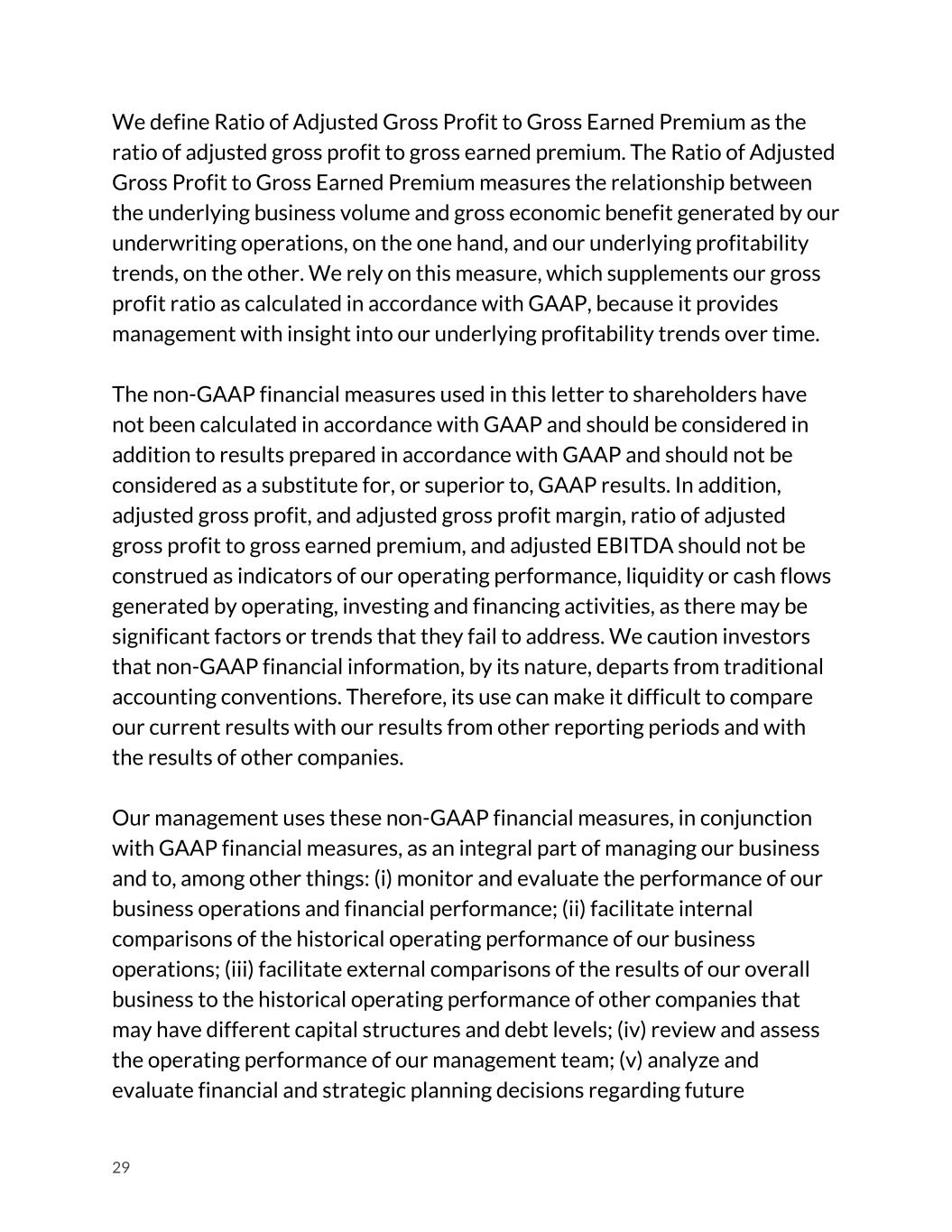
We define Ratio of Adjusted Gross Profit to Gross Earned Premium as the ratio of adjusted gross profit to gross earned premium. The Ratio of Adjusted Gross Profit to Gross Earned Premium measures the relationship between the underlying business volume and gross economic benefit generated by our underwriting operations, on the one hand, and our underlying profitability trends, on the other. We rely on this measure, which supplements our gross profit ratio as calculated in accordance with GAAP, because it provides management with insight into our underlying profitability trends over time. The non-GAAP financial measures used in this letter to shareholders have not been calculated in accordance with GAAP and should be considered in addition to results prepared in accordance with GAAP and should not be considered as a substitute for, or superior to, GAAP results. In addition, adjusted gross profit, and adjusted gross profit margin, ratio of adjusted gross profit to gross earned premium, and adjusted EBITDA should not be construed as indicators of our operating performance, liquidity or cash flows generated by operating, investing and financing activities, as there may be significant factors or trends that they fail to address. We caution investors that non-GAAP financial information, by its nature, departs from traditional accounting conventions. Therefore, its use can make it difficult to compare our current results with our results from other reporting periods and with the results of other companies. Our management uses these non-GAAP financial measures, in conjunction with GAAP financial measures, as an integral part of managing our business and to, among other things: (i) monitor and evaluate the performance of our business operations and financial performance; (ii) facilitate internal comparisons of the historical operating performance of our business operations; (iii) facilitate external comparisons of the results of our overall business to the historical operating performance of other companies that may have different capital structures and debt levels; (iv) review and assess the operating performance of our management team; (v) analyze and evaluate financial and strategic planning decisions regarding future 29
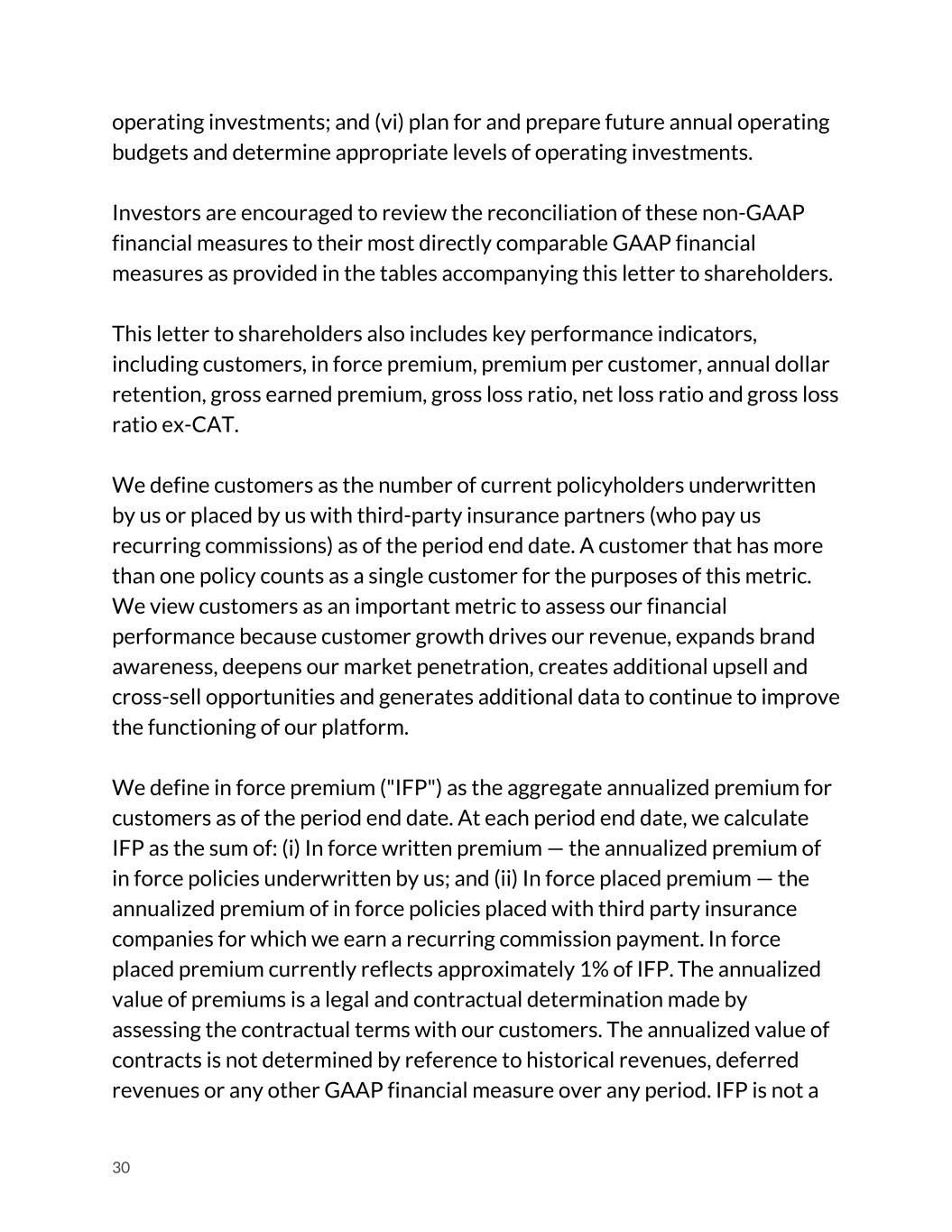
operating investments; and (vi) plan for and prepare future annual operating budgets and determine appropriate levels of operating investments. Investors are encouraged to review the reconciliation of these non-GAAP financial measures to their most directly comparable GAAP financial measures as provided in the tables accompanying this letter to shareholders. This letter to shareholders also includes key performance indicators, including customers, in force premium, premium per customer, annual dollar retention, gross earned premium, gross loss ratio, net loss ratio and gross loss ratio ex-CAT. We define customers as the number of current policyholders underwritten by us or placed by us with third-party insurance partners (who pay us recurring commissions) as of the period end date. A customer that has more than one policy counts as a single customer for the purposes of this metric. We view customers as an important metric to assess our financial performance because customer growth drives our revenue, expands brand awareness, deepens our market penetration, creates additional upsell and cross-sell opportunities and generates additional data to continue to improve the functioning of our platform. We define in force premium ("IFP") as the aggregate annualized premium for customers as of the period end date. At each period end date, we calculate IFP as the sum of: (i) In force written premium — the annualized premium of in force policies underwritten by us; and (ii) In force placed premium — the annualized premium of in force policies placed with third party insurance companies for which we earn a recurring commission payment. In force placed premium currently reflects approximately 1% of IFP. The annualized value of premiums is a legal and contractual determination made by assessing the contractual terms with our customers. The annualized value of contracts is not determined by reference to historical revenues, deferred revenues or any other GAAP financial measure over any period. IFP is not a 30

forecast of future revenues nor is it a reliable indicator of revenue expected to be earned in any given period. We believe that our calculation of IFP is useful to analysts and investors because it captures the impact of growth in customers and premium per customer at the end of each reported period, without adjusting for known or projected policy updates, cancellations, rescissions and non-renewals. We use IFP because we believe it gives our management useful insight into the total reach of our platform by showing all in force policies underwritten and placed by us. Other companies, including companies in our industry, may calculate IFP differently or not at all, which reduces the usefulness of IFP as a tool for comparison. We define premium per customer as the average annualized premium customers pay for products underwritten by us or placed by us with third- party insurance partners. We calculate premium per customer by dividing IFP by customers. We view premium per customer as an important metric to assess our financial performance because premium per customer reflects the average amount of money our customers spend on our products, which helps drive strategic initiatives. We define annual dollar retention ("ADR"), as the percentage of IFP retained over a twelve month period, inclusive of changes in policy value, changes in number of policies, changes in policy type, and churn. To calculate ADR we first aggregate the IFP from all active customers at the beginning of the period and then aggregate the IFP from those same customers at the end of the period. ADR is then equal to the ratio of ending IFP to beginning IFP. We believe that our calculation of ADR is useful to analysts and investors because it captures our ability to retain customers and sell additional products and coverage to them over time. We view ADR as an important metric to measure our ability to provide a delightful end-to-end customer experience, satisfy our customers’ evolving insurance needs and maintain our customers’ trust in our products. Our customers become more valuable to us every year they continue to subscribe to our products. Other companies, 31

including companies in our industry, may calculate ADR differently or not at all, which reduces the usefulness of ADR as a tool for comparison. Gross earned premium ("GEP") is the earned portion of our gross written premium. Gross earned premium includes direct and assumed premium. In December 2022, we began assuming premium related to car insurance policies written in Texas, in connection with our fronting arrangement with a third party carrier in Texas, and this did not impact the key performance indicators prior to fourth quarter of 2022. We use this operating metric as we believe it gives our management and other users of our financial information useful insight into the gross economic benefit generated by our business operations and allows us to evaluate our underwriting performance without regard to changes in our underlying reinsurance structure. Unlike net earned premium, gross earned premium excludes the impact of premiums ceded to reinsurers, and therefore should not be used as a substitute for net earned premium, total revenue, or any other measure presented in accordance with GAAP. We define gross loss ratio, expressed as a percentage, as the ratio of losses and loss adjustment expense to gross earned premium. We define net loss ratio, expressed as a percentage, as the ratio of losses and loss adjustment expense, less amounts ceded to reinsurers, to net earned premium. We define gross loss ratio ex-CAT, expressed as a percentage, as the ratio of gross losses and loss adjustment expense, excluding catastrophic losses, to gross earned premium. We define net cash flow as the change in cash and investments. 32

Links The information contained on, or that can be accessed through, hyperlinks included herein is deemed not to be incorporated in or part of this shareholder letter. Earnings teleconference information The Company will discuss its fourth quarter and full year ended December 31, 2023 financial results and business outlook during a teleconference on February 28, 2024, at 8:00 AM ET. The conference call (access code 941644) can be accessed toll-free at 1-833-470-1428, or at 1-404-975-4839. A live audio webcast of the call will also be available simultaneously at https://investor.lemonade.com Following completion of the call, a recorded replay of the webcast will be available on the investor relations section of Lemonade’s website. Additional investor information can be accessed at https://investor.lemonade.com About Lemonade Lemonade offers renters, homeowners, pet, car, and life insurance. Powered by artificial intelligence and behavioral economics, Lemonade’s full stack insurance carriers in the US, the UK and the EU replace brokers and bureaucracy with bots and machine learning, aiming for zero paperwork and instant everything. A Certified B-Corp, Lemonade donates to nonprofits selected by its community, during its annual Giveback. Lemonade is currently available in the United States, the UK, Germany, the Netherlands, and France, and continues to expand globally. 33
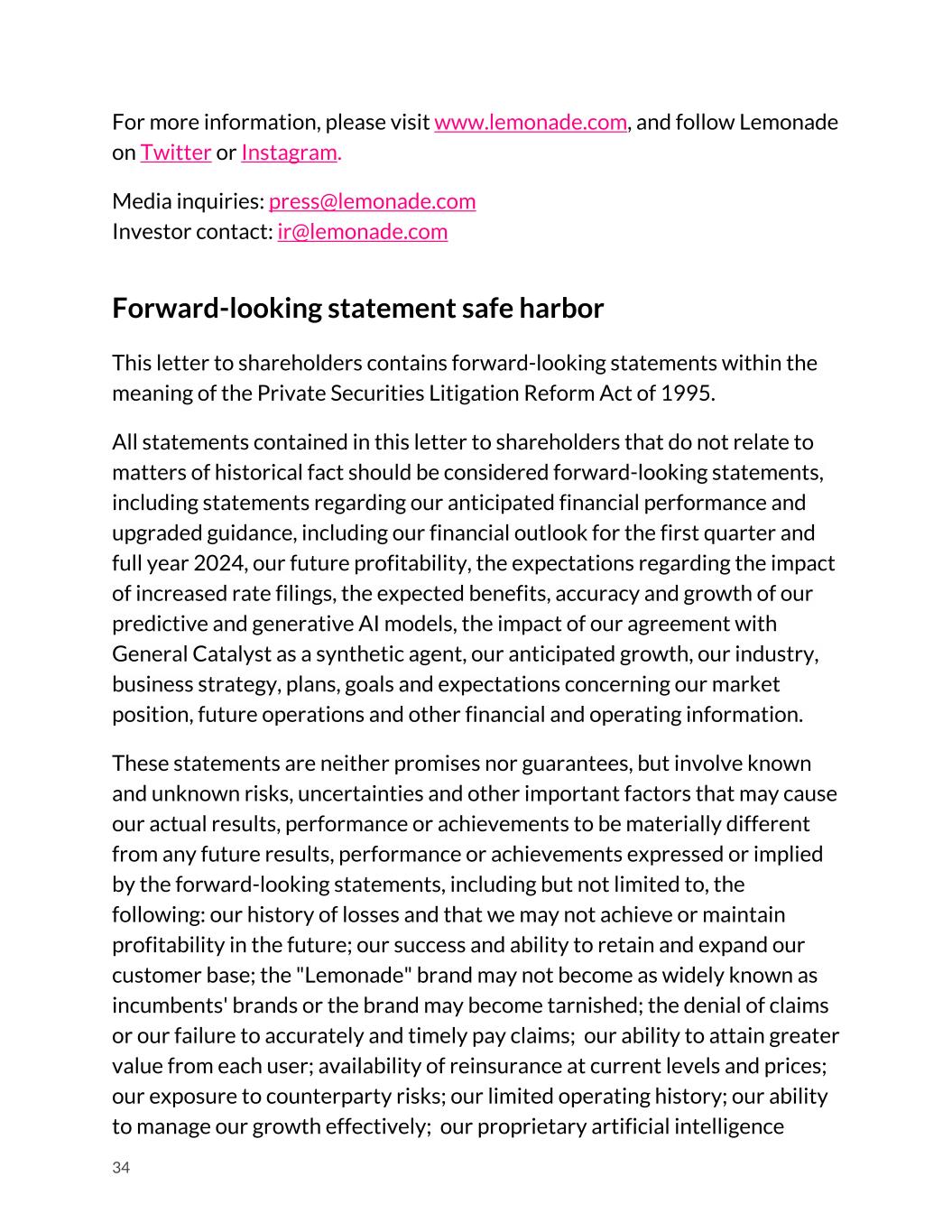
For more information, please visit www.lemonade.com, and follow Lemonade on Twitter or Instagram. Media inquiries: press@lemonade.com Investor contact: ir@lemonade.com Forward-looking statement safe harbor This letter to shareholders contains forward-looking statements within the meaning of the Private Securities Litigation Reform Act of 1995. All statements contained in this letter to shareholders that do not relate to matters of historical fact should be considered forward-looking statements, including statements regarding our anticipated financial performance and upgraded guidance, including our financial outlook for the first quarter and full year 2024, our future profitability, the expectations regarding the impact of increased rate filings, the expected benefits, accuracy and growth of our predictive and generative AI models, the impact of our agreement with General Catalyst as a synthetic agent, our anticipated growth, our industry, business strategy, plans, goals and expectations concerning our market position, future operations and other financial and operating information. These statements are neither promises nor guarantees, but involve known and unknown risks, uncertainties and other important factors that may cause our actual results, performance or achievements to be materially different from any future results, performance or achievements expressed or implied by the forward-looking statements, including but not limited to, the following: our history of losses and that we may not achieve or maintain profitability in the future; our success and ability to retain and expand our customer base; the "Lemonade" brand may not become as widely known as incumbents' brands or the brand may become tarnished; the denial of claims or our failure to accurately and timely pay claims; our ability to attain greater value from each user; availability of reinsurance at current levels and prices; our exposure to counterparty risks; our limited operating history; our ability to manage our growth effectively; our proprietary artificial intelligence 34

algorithms may not operate properly or as expected; the intense competition in the segments of the insurance industry in which we operate; our ability to maintain our risk-based capital at the required levels; our ability to expand our product offerings; the novelty of our business model and its unpredictable efficacy and susceptibility to unintended consequences; the possibility that we could be forced to modify or eliminate our Giveback; regulatory risks, related to the operation, development, and implementation of our proprietary artificial intelligence algorithms and telematics based pricing model; legislation or legal requirements that may affect how we communicate with customers; the cyclical nature of the insurance industry; our reliance on artificial intelligence, telematics, mobile technology, and our digital platforms to collect data that we utilize in our business; our ability to obtain additional capital to the extent required to grow our business, which may not be available on terms acceptable to us or at all; our actual or perceived failure to protect customer information and other data as a result of security incidents or real or perceived errors, failures or bugs in our systems, website or app, respect customers’ privacy, or comply with data privacy and security laws and regulations; periodic examinations by state insurance regulators; underwriting risks accurately and charging competitive yet profitable rates to customers; our ability to underwrite risks accurately and charge competitive yet profitable rates to our customers; potentially significant expenses incurred in connection with any new products before generating revenue from such products; risks associated with any costs incurred and other risks as we expand our business in the U.S. and internationally; our ability to comply with extensive insurance industry regulations; our ability to comply with insurance regulators and additional reporting requirements on insurance holding companies; our ability to predict the impacts of severe weather events and catastrophes, including the effects of climate change and global pandemics, on our business and the global economy generally; increasing scrutiny, actions, and changing expectations on environmental, social, and governance matters; our agreement with General Catalyst as a synthetic agent may not function as expected; fluctuations of our results of operations on a quarterly and annual basis; our utilization of customer and third party data in underwriting our 35

policies; limitations in the analytical models used to assess and predict our exposure to catastrophe losses; potential losses could be greater than our loss and loss adjustment expense reserves; the minimum capital and surplus requirements our insurance subsidiaries are required to have; assessments and other surcharges from state guaranty funds; our status and obligations as a public benefit corporation; our operations in Israel and the current political, economic, and military instability, including the evolving conflict in Israel and surrounding region. These and other important factors are discussed under the caption “Risk Factors” in our Form 10-K filed with the SEC on March 3, 2023, our Quarterly Report on Form 10-Q for the period ended September 30, 2023 filed with the SEC on November 3, 2023 and in our other and subsequent filings with the SEC, including our Form 10-K to be filed for the year ended December 31, 2023 which could cause actual results to differ materially from those indicated by the forward-looking statements made in this letter to shareholders. Any such forward-looking statements represent management’s beliefs as of the date of this letter to shareholders. While we may elect to update such forward-looking statements at some point in the future, we disclaim any obligation to do so, even if subsequent events cause our views to change. 36

Consolidated Statements of Operations and Comprehensive Loss $ in millions, except per share amounts Three Months Ended December 31, Year Ended December 31, 2023 2022 2023 2022 (unaudited) Revenue Net earned premium $ 83.9 $ 63.2 $ 315.2 $ 172.4 Ceding commission income 18.4 17.7 69.8 64.1 Net investment income 7.1 3.7 24.7 8.4 Commission and other income 6.1 3.8 20.1 11.8 Total revenue 115.5 88.4 429.8 256.7 Expense Loss and loss adjustment expense, net 65.0 61.5 280.4 167.3 Other insurance expense 15.5 13.1 59.2 44.0 Sales and marketing 24.5 27.2 101.9 138.3 Technology development 21.1 23.5 88.8 79.6 General and administrative 29.0 31.2 129.3 122.3 Total expense 155.1 156.5 659.6 551.5 Loss before income taxes (39.6) (68.1) (229.8) (294.8) Income tax expense 2.8 (4.4) 7.1 3.0 Net loss $ (42.4) $ (63.7) $ (236.9) $ (297.8) Other comprehensive income (loss), net of tax Unrealized gain (loss) on investments in fixed maturities 8.5 5.4 18.6 (18.4) Foreign currency translation adjustment 1.6 2.3 — (5.8) Comprehensive loss $ (32.3) $ (56.0) $ (218.3) $ (322.0) Per share data: Net loss per share attributable to common stockholders — basic and diluted $ (0.61) $ (0.93) $ (3.40) $ (4.59) Weighted average common shares outstanding — basic and diluted 70,004,840 69,190,353 69,658,912 64,921,524 37
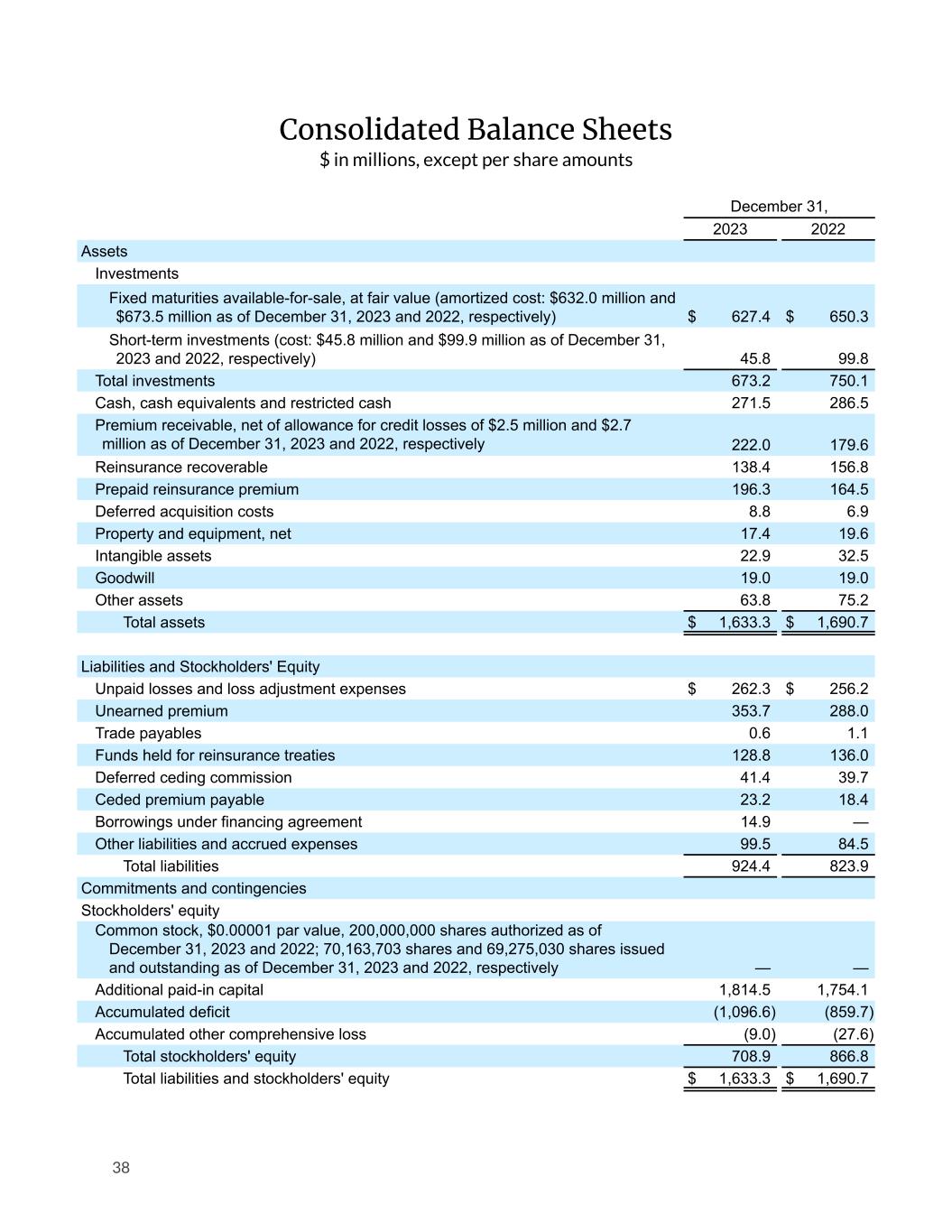
Consolidated Balance Sheets $ in millions, except per share amounts December 31, 2023 2022 Assets Investments Fixed maturities available-for-sale, at fair value (amortized cost: $632.0 million and $673.5 million as of December 31, 2023 and 2022, respectively) $ 627.4 $ 650.3 Short-term investments (cost: $45.8 million and $99.9 million as of December 31, 2023 and 2022, respectively) 45.8 99.8 Total investments 673.2 750.1 Cash, cash equivalents and restricted cash 271.5 286.5 Premium receivable, net of allowance for credit losses of $2.5 million and $2.7 million as of December 31, 2023 and 2022, respectively 222.0 179.6 Reinsurance recoverable 138.4 156.8 Prepaid reinsurance premium 196.3 164.5 Deferred acquisition costs 8.8 6.9 Property and equipment, net 17.4 19.6 Intangible assets 22.9 32.5 Goodwill 19.0 19.0 Other assets 63.8 75.2 Total assets $ 1,633.3 $ 1,690.7 Liabilities and Stockholders' Equity Unpaid losses and loss adjustment expenses $ 262.3 $ 256.2 Unearned premium 353.7 288.0 Trade payables 0.6 1.1 Funds held for reinsurance treaties 128.8 136.0 Deferred ceding commission 41.4 39.7 Ceded premium payable 23.2 18.4 Borrowings under financing agreement 14.9 — Other liabilities and accrued expenses 99.5 84.5 Total liabilities 924.4 823.9 Commitments and contingencies Stockholders' equity Common stock, $0.00001 par value, 200,000,000 shares authorized as of December 31, 2023 and 2022; 70,163,703 shares and 69,275,030 shares issued and outstanding as of December 31, 2023 and 2022, respectively — — Additional paid-in capital 1,814.5 1,754.1 Accumulated deficit (1,096.6) (859.7) Accumulated other comprehensive loss (9.0) (27.6) Total stockholders' equity 708.9 866.8 Total liabilities and stockholders' equity $ 1,633.3 $ 1,690.7 38

Consolidated Statements of Cash Flows $ in millions Year Ended December 31, 2023 2022 Cash flows from operating activities: Net loss $ (236.9) $ (297.8) Adjustments to reconcile net loss to net cash used in operating activities: Depreciation and amortization 20.0 12.2 Stock-based compensation 59.9 59.3 Amortization of premium (discount) on bonds (2.6) 6.7 Provision for bad debt 8.1 8.7 Asset impairment charge 3.7 — Changes in operating assets and liabilities: Premium receivable (50.5) (43.8) Reinsurance recoverable 18.4 (52.6) Prepaid reinsurance premium (31.8) (14.9) Deferred acquisition costs (1.9) (0.8) Other assets 8.9 (7.0) Unpaid losses and loss adjustment expenses 6.1 74.0 Unearned premium 65.7 65.1 Trade payables (0.5) (0.7) Funds held for reinsurance treaties (7.2) 32.9 Deferred ceding commission 1.7 3.2 Ceded premium payable 4.8 (12.4) Other liabilities and accrued expenses 15.0 4.9 Net cash used in operating activities (119.1) (163.0) Cash flows from investing activities: Acquisition of business, net of cash acquired — 98.8 Proceeds from short-term investments sold or matured 143.5 224.5 Proceeds from bonds sold or matured 349.6 138.0 Cost of short-term investments acquired (71.5) (136.7) Cost of bonds acquired (323.7) (133.4) Purchases of property and equipment (9.2) (10.1) Net cash provided by investing activities 88.7 181.1 Cash flows from financing activities: Proceeds from borrowings under financing agreement 19.1 — Payment on borrowings under financing agreement (4.2) — Proceeds from stock exercises 0.5 3.6 Net cash provided by financing activities 15.4 3.6 Effect of exchange rate changes on cash, cash equivalents and restricted cash — (5.8) Net increase (decrease) in cash, cash equivalents and restricted cash (15.0) 15.9 Cash, cash equivalents and restricted cash at beginning of year 286.5 270.6 Cash, cash equivalents and restricted cash at end of year $ 271.5 $ 286.5 Supplemental disclosure of cash flow information: Cash paid for income taxes $ 0.7 $ 3.4 Cash paid for interest expense on borrowings under financing agreement $ 0.3 $ — Non-cash transactions: Warrants assumed from acquisition of Metromile $ — $ 0.3 39
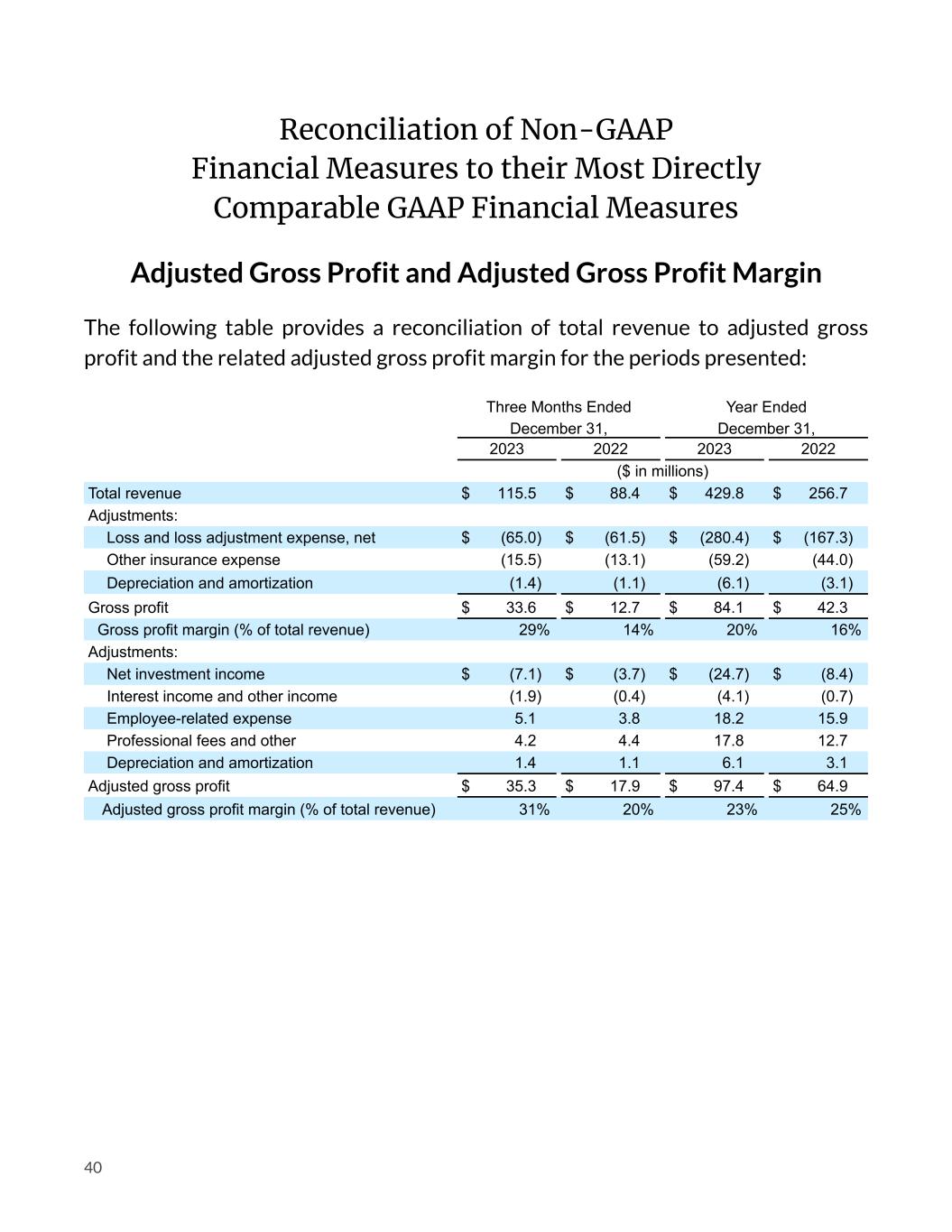
Reconciliation of Non-GAAP Financial Measures to their Most Directly Comparable GAAP Financial Measures Adjusted Gross Profit and Adjusted Gross Profit Margin The following table provides a reconciliation of total revenue to adjusted gross profit and the related adjusted gross profit margin for the periods presented: Three Months Ended December 31, Year Ended December 31, 2023 2022 2023 2022 ($ in millions) Total revenue $ 115.5 $ 88.4 $ 429.8 $ 256.7 Adjustments: Loss and loss adjustment expense, net $ (65.0) $ (61.5) $ (280.4) $ (167.3) Other insurance expense (15.5) (13.1) (59.2) (44.0) Depreciation and amortization (1.4) (1.1) (6.1) (3.1) Gross profit $ 33.6 $ 12.7 $ 84.1 $ 42.3 Gross profit margin (% of total revenue) 29% 14% 20% 16% Adjustments: Net investment income $ (7.1) $ (3.7) $ (24.7) $ (8.4) Interest income and other income (1.9) (0.4) (4.1) (0.7) Employee-related expense 5.1 3.8 18.2 15.9 Professional fees and other 4.2 4.4 17.8 12.7 Depreciation and amortization 1.4 1.1 6.1 3.1 Adjusted gross profit $ 35.3 $ 17.9 $ 97.4 $ 64.9 Adjusted gross profit margin (% of total revenue) 31% 20% 23% 25% 40

Ratio of Adjusted Gross Profit to Gross Earned Premium The following table sets forth our calculation of the Ratio of Adjusted Gross Profit to Gross Earned Premium for the periods presented: Three Months Ended December 31, Year Ended December 31, 2023 2022 2023 2022 ($ in millions) Numerator: Adjusted gross profit $ 35.3 $ 17.9 $ 97.4 $ 64.9 Denominator: Gross earned premium $ 181.0 $ 151.3 $ 672.3 $ 490.5 Ratio of Adjusted Gross Profit to Gross Earned Premium 20% 12% 14% 13% Adjusted EBITDA The following table provides a reconciliation of adjusted EBITDA to net loss for the periods presented: Three Months Ended December 31, Year Ended December 31, 2023 2022 2023 2022 ($ in millions) Net loss $ (42.4) $ (63.7) $ (236.9) $ (297.8) Adjustments: Income tax expense 2.8 (4.4) 7.1 3.0 Depreciation and amortization 4.8 5.4 20.0 12.2 Stock-based compensation (1) 14.3 15.7 59.9 58.5 Transaction and integration costs from Metromile acquisition — — — 8.4 Interest income and others (1.2) (0.5) (3.2) (0.8) Net investment income (7.1) (3.7) (24.7) (8.4) Change in fair value of warrants liability — (0.5) (0.3) (0.2) Amortization of fair value adjustment on insurance contract intangible liability relating to the Metromile acquisition (0.1) — (1.2) — Other adjustments (2) — — 6.7 — Adjusted EBITDA $ (28.9) $ (51.7) $ (172.6) $ (225.1) (1) Includes compensation expense related to warrant shares of $2.5 million for the year ended December 31, 2023. (2) Includes impairment charge of $3.7 million related to the San Francisco office sublease and $3.0 million accrual for a potential liability claim, both related to Metromile. 41
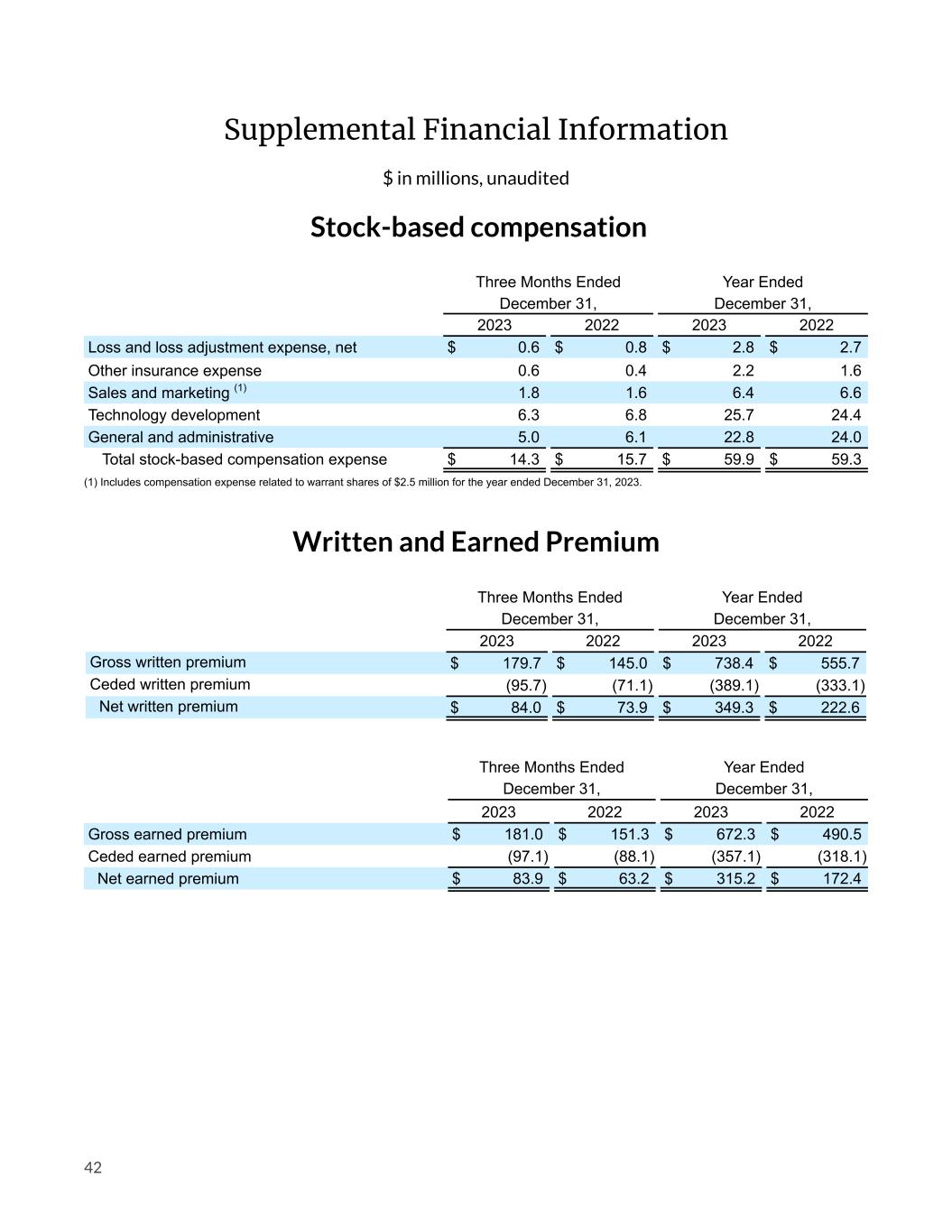
Supplemental Financial Information $ in millions, unaudited Stock-based compensation Three Months Ended December 31, Year Ended December 31, 2023 2022 2023 2022 Loss and loss adjustment expense, net $ 0.6 $ 0.8 $ 2.8 $ 2.7 Other insurance expense 0.6 0.4 2.2 1.6 Sales and marketing (1) 1.8 1.6 6.4 6.6 Technology development 6.3 6.8 25.7 24.4 General and administrative 5.0 6.1 22.8 24.0 Total stock-based compensation expense $ 14.3 $ 15.7 $ 59.9 $ 59.3 (1) Includes compensation expense related to warrant shares of $2.5 million for the year ended December 31, 2023. Written and Earned Premium Three Months Ended December 31, Year Ended December 31, 2023 2022 2023 2022 Gross written premium $ 179.7 $ 145.0 $ 738.4 $ 555.7 Ceded written premium (95.7) (71.1) (389.1) (333.1) Net written premium $ 84.0 $ 73.9 $ 349.3 $ 222.6 Three Months Ended December 31, Year Ended December 31, 2023 2022 2023 2022 Gross earned premium $ 181.0 $ 151.3 $ 672.3 $ 490.5 Ceded earned premium (97.1) (88.1) (357.1) (318.1) Net earned premium $ 83.9 $ 63.2 $ 315.2 $ 172.4 42

Historical Operating Metrics $ in millions except Premium per customer Dec. 31, Mar. 31, Jun. 30, Sept. 30, Dec. 31, Mar. 31 Jun. 30, Sep. 30, Dec. 31, 2021 2022 2022 2022 2022 2023 2023 2023 2023 Customers (end of period) 1,427,481 1,504,197 1,579,936 1,775,824 1,807,548 1,856,012 1,906,408 1,984,154 2,026,918 In force premium (end of period) $ 380.1 $ 419.0 $ 457.6 $ 609.2 $ 625.1 $ 653.3 $ 686.6 $ 719.0 $ 747.3 Premium per customer (end of period) $ 266 $ 279 $ 290 $ 343 $ 346 $ 352 $ 360 $ 362 $ 369 Annual dollar retention (end of period) 82% 82% 83% 84% 86% 87% 87% 85% 87% Total revenue $ 41.0 $ 44.3 $ 50.0 $ 74.0 $ 88.4 $ 95.2 $ 104.6 $ 114.5 $ 115.5 Gross earned premium $ 89.3 $ 96.0 $ 106.8 $ 136.4 $ 151.3 $ 154.2 $ 163.9 $ 173.2 $ 181.0 Gross profit $ 7.8 $ 10.2 $ 11.3 $ 8.1 $ 12.7 $ 16.5 $ 12.1 $ 21.9 $ 33.6 Adjusted gross profit $ 12.6 $ 16.3 $ 17.5 $ 13.2 $ 17.9 $ 20.6 $ 16.6 $ 24.9 $ 35.3 Net loss $ (70.3) $ (74.8) $ (67.9) $ (91.4) $ (63.7) $ (65.8) $ (67.2) $ (61.5) $ (42.4) Adjusted EBITDA $ (51.2) $ (57.4) $ (50.3) $ (65.7) $ (51.7) $ (50.8) $ (52.7) $ (40.2) $ (28.9) Gross profit margin 19% 23% 23% 11% 14% 17% 12% 19% 29% Adjusted gross profit margin 31% 37% 35% 18% 20% 22% 16% 22% 31% Ratio of Adjusted Gross Profit to Gross Earned Premium 14% 17% 16% 10% 12% 13% 10% 14% 20% Gross loss ratio 96% 90% 86% 94% 89% 87% 94% 83% 77% Net loss ratio 98% 89% 90% 105% 97% 93% 99% 88% 78% 43

Appendix to the Q4 2023 Shareholder Letter
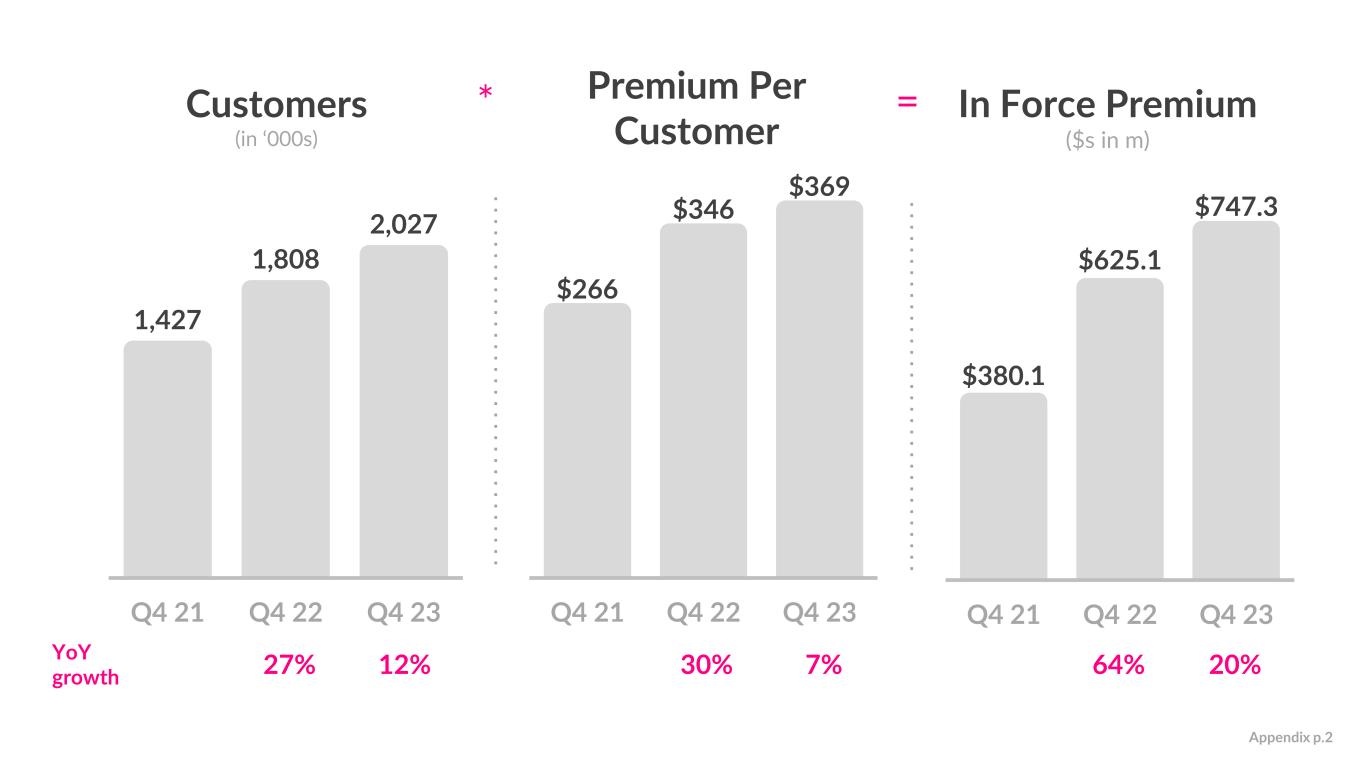
Customers (in ‘000s) In Force Premium ($s in m) 12% 27% YoY growth 20%64% 1,427 1,808 2,027 Q4 21 Q4 22 Q4 23 $380.1 $625.1 $747.3 Q4 21 Q4 22 Q4 23 $266 $346 $369 Q4 21 Q4 22 Q4 23 Premium Per Customer 7% 30% * = Appendix p.2

Gross Earned Premium (“GEP”) ($s in m) Revenue ($s in m) $41.0 $88.4 $115.5 Q4 21 Q4 22 Q4 23 31%116%YoY growth $89.3 $151.3 $181.0 Q4 21 Q4 22 Q4 23 20% 69% Appendix p.3

89% 87% 94% 83% 77% 97% 93% 99% 88% 78% 79% 72% 73% 73% 72% Q4 22 Q1 23 Q2 23 Q3 23 Q4 23 Loss Ratio Gross Loss Ratio (1) Net Loss Ratio (1) (1) We define gross loss ratio, expressed as a percentage, as the ratio of losses and loss adjustment expense to gross earned premium, and net loss ratio, expressed as a percentage, as the ratio of losses and loss adjustment expense, less amounts ceded to reinsurers, to net earned premium. (2) We define gross loss ratio ex-CAT, expressed as a percentage, as the ratio of losses and loss adjustment expense excluding catastrophic losses to gross earned premium. Appendix p.4 Gross Loss Ratio ex-CAT (2)

Gross Profit ($s in m) Gross Profit Margin 165%63% 19% 14% 29% Q4 21 Q4 22 Q4 23 YoY growth Appendix p.5 $7.8 $12.7 $33.6 Q4 21 Q4 22 Q4 23

Adj. Gross Profit (1) ($s in m) Ratio of Adj. Gross Profit to GEP $12.6 $17.9 $35.3 Q4 21 Q4 22 Q4 23 97%42% (1) This is a non-GAAP metric. For a description of these metrics and a reconciliation to the most directly comparable GAAP measure, please see "Reconciliation of Non-GAAP Financial Measures to GAAP" and "Non-GAAP financial measures and key operating metrics". 14% 12% 20% Q4 21 Q4 22 Q4 23 YoY growth Appendix p.6

($84.5) ($95.0) ($90.1) Q4 21 Q4 22 Q4 23 Other insurance expense Sales and marketing Technology development General and administrative Operating Expenses (1) ($s in m) (1) Represents total expense less loss and loss adjustment expense, net. Appendix p.7

Net Loss ($s in m) Adj. EBITDA (1) ($s in m) 44%(1%) YoY growth 33% 9% (1) This is a non-GAAP metric. For a description of these metrics and a reconciliation to the most directly comparable GAAP measure, please see "Reconciliation of Non-GAAP Financial Measures to GAAP" and "Non-GAAP financial measures and key operating metrics". Appendix p.8 ($70.3) ($63.7) ($42.4) Q4 21 Q4 22 Q4 23 ($51.2) ($51.7) ($28.9) Q4 21 Q4 22 Q4 23

Guidance ($s in m) Q1 2024 Full Year 2024 $789 $791 $183 $185 $111 $113 ($43) ($41) ($160) ($155) $505 $510 $815 $820 $938 $942 Low High Low High In Force Premium (as of end of period) Gross Earned Premium Revenue Adj. EBITDA (1) (1) Adj. EBITDA is a non-GAAP metric. A full reconciliation of Adj. EBITDA guidance to net loss on a forward-looking basis cannot be provided without unreasonable efforts, as we are unable to provide reconciling information with respect to income tax expense, depreciation and amortization, interest income, net investment income, and other transactions that we consider to be unique in nature, all of which are adjustments to Adj. EBITDA. We estimate that stock-based compensation for the first quarter and full year 2024 is approximately $15m and $60m, respectively. We estimate that Capital expenditures for the first quarter and full year 2024 is approximately $2m and $10m, respectively. We estimate weighted total common shares outstanding for the first quarter and full year 2024 is approximately 70m and 71m, respectively. Appendix p.9

Adjusted Gross Profit (1) (1) This is a non-GAAP metric. For a description of these metrics and a reconciliation to the most directly comparable GAAP measure, please see "Reconciliation of Non-GAAP Financial Measures to GAAP" and "Non-GAAP financial measures and key operating metrics". Three Months Ended Q3 2022 Q4 2022 Q1 2023 Q2 2023 Q3 2023 Q4 2023 ($ in millions) GAAP gross profit $ 8.1 $ 12.7 $ 16.5 $ 12.1 $ 21.9 $ 33.6 Adjustments: Net investment income $ (2.6) $ (3.7) $ (5.0) $ (5.6) $ (7.0) $ (7.1) Interest income (0.3) (0.4) (0.7) (0.8) (0.7) (1.9) Employee-related expense 3.9 3.8 3.8 4.7 4.6 5.1 Professional fees and other 3.6 4.4 4.5 4.6 4.5 4.2 Depreciation and amortization 0.5 1.1 1.5 1.6 1.6 1.4 Adjusted gross profit $ 13.2 $ 17.9 $ 20.6 $ 16.6 $ 24.9 $ 35.3 Appendix p.10

Adjusted EBITDA (1) (1) This is a non-GAAP metric. For a description of these metrics and a reconciliation to the most directly comparable GAAP measure, please see "Reconciliation of Non-GAAP Financial Measures to GAAP" and "Non-GAAP financial measures and key operating metrics". Three Months Ended Q3 2022 Q4 2022 Q1 2023 Q2 2023 Q3 2023 Q4 2023 ($ in millions) Net loss $ (91.4) $ (63.7) $ (65.8) $ (67.2) $ (61.5) $ (42.4) Adjustments: Income tax expense 2.3 (4.4) 1.1 1.3 1.9 2.8 Depreciation and amortization 3.8 5.4 5.2 5.0 5.0 4.8 Stock-based compensation 14.8 15.7 15.4 14.8 15.4 14.3 Transaction and integration costs from Metromile acquisition 7.4 - - - - - Interest income and others (0.3) (0.5) (0.7) (0.8) (0.5) (1.2) Net investment income (2.6) (3.7) (5.0) (5.6) (7.0) (7.1) Change in fair value of warrants liability 0.3 (0.5) (0.3) - - - Amortization of fair value adjustment on insurance contract intangible liability relating to the Metromile acquisition - - (0.7) (0.2) (0.2) (0.1) Other adjustments - - - - 6.7 - Adjusted EBITDA $ (65.7) $ (51.7) $ (50.8) $ (52.7) $ (40.2) $ (28.9) Appendix p.11